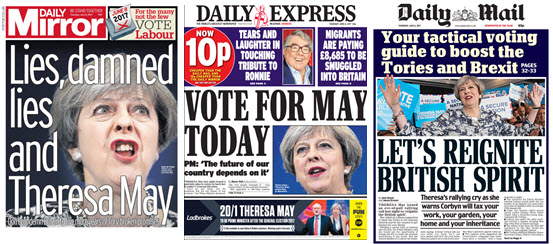
Apart from making us all instant experts on the intricacies of the politics of Northern Ireland, last week’s UK election can teach us a lot about the changing nature and role of the media in politics.
First, there’s some promising signs that the war against fake news is being won — not so much through tweaking of algorithms as through people thinking for themselves. The more people know about fake news, the more they push back — and the more they demand from journalism.
According to a data memo released by Oxford University’s Project on Computational Propaganda, only about 11.4% of information circulated on Twitter during the UK election was what the paper characterised as “junk news”. This contrasted to almost three times as much junk (33.8%) in a similar study of Twitter in Michigan in the lead-up to last year’s US presidential election.
At the same time, the proportion of Twitter links to what the paper describes as “content from professional news services” was 53.6% in the UK election, compared to 33.5% in the Michigan sample.
For supporters of quality journalism, there’s the added tidbit that over 40% of the links to professional news services were to either the BBC or The Guardian.
Similar studies by the university project in elections in France and Germany between February and April showed similar results to the UK.
In a suitably snooty British way, the university paper highlights the outcome as demonstrating a distinction between Europe and the US, saying: “UK users shared better quality information than that which many US users shared during the 2016 US election, but worse quality news and information than was shared during the French 2017 election.”
But the European comparisons show how quickly perceptions have changed since Trump’s election. Awareness about “fake news” (based on search and usage) exploded after the US election. The European comparisons may indicate a greater sophistication in the old world, but the timing is more relevant.
Perhaps the key battle of the past six or so months has been to determine just what we mean by “fake news”. Once Trump led the political class to characterise anything they disagreed with as fake news, it threatened to become yet another tool for bashing journalists.
[Fake news is not new, and a Senate inquiry into it would be a colossal waste of time]
It’s a hard paradox that a term meant to distinguish professional, ethical journalism from maliciously falsified information that steals the design to conceal its falseness threatened to become a term of abuse to undermine journalism itself.
In January, The Washington Post’s media writer Margaret Sullivan called for us to abandon the phrase, saying: “Instead, call a lie a lie. Call a hoax a hoax. Call a conspiracy theory by its rightful name. After all, ‘fake news’ is an imprecise expression to begin with.”
Imprecise, sure. But evocative as well. It’s been hard to let it go.
And now we’ve got the journalistic equivalent of an Apostolic Exhortation from the US Associated Press Style Guide to help. Early this month as part of the release of its updated guide, it tweeted:
The term “fake news” may be used for deliberate falsehoods or fiction masked as news circulating on the internet. #APStyleChat (1/3)
But don’t label as fake news specific news items that are disputed. If fake news is used in a quote, ask for details. #APStyleChat (2/3)
Alternatives: erroneous reports, unverified reports, questionable reports, disputed reports, depending on context. #APStyleChat (3/3)
So that’s settled then. Except that in the public’s eye, the line between professionally prepared news and the malicious lies we call fake news is not as clear-cut
This is the second lesson from the UK election, where the British Tory tabloid red tops — particularly The Sun and the Daily Mail — have long filled the niche that Fox News occupies in the US. On one reading, the modern usage of “fake news” derives its etymology from Fox (Fox News to Faux News to Fake News), so we shouldn’t be surprised that the red- tops’ brand gets at least a side swipe in the fake news car wreck.
[Sorry, ‘fake news’ isn’t information you don’t like]
Famously, it was The Sun that bragged on its front page after the narrow conservative win in 1991: “IT’S THE SUN WOT WON IT.” This year, they attempted a repeat with their election day front page: “Don’t chuck Britain in the Cor-Bin.” As headlines go, it was a bit short of the “Headless body in topless bar” class and this time it didn’t fall into the media vacuum of the early ’90s.
Now, a front page only delivers power where it becomes amplified through social media. Instead, social media responded with images of The Sun (and the guilty-by-association Daily Mail) tossed into the bin and set on fire.
Tying your paper to a party is a great strategy when the party wins. But, perhaps, this election result also means that the planned take-over of UK Sky by The Sun’s sister organisation 20th Century Fox may have also ended up in Britain’s political bin.
*h/t to Laura Hazard Owen, from Nieman Lab, whose excellent weekly round-up of real news about fake news highlighted the Oxford University report.







Wonderful to see the Murdoch press shown up as fools, yet again. I’m waiting for them to be shown up for their support of that total convefe who is the “supposed” leader of the USA.
So comforting to see the old Murdoch spider losing his grip.
Best. Headline. Ever.
http://tdifh.blogspot.com.au/2015/02/8-february-2000-best-headline-ever.html
‘Wonderful to see the Murdoch press shown up as fools, yet again’ – AMEN!